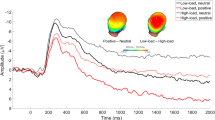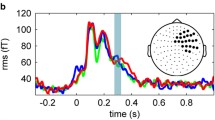Abstract
Throughout our day-to-day activities, we are subjected to numerous stimuli that compete for our attention; consequently, we must prioritize stimuli for further processing and influence over behaviour. Previous research has demonstrated that the extent to which task-irrelevant distractors are processed is mediated by the nature of the cognitive task, and the level of processing load. Importantly though, the interaction between cognitive task, processing load, and emotional distractor processing remains unclear. This is a particularly important question given the unique ways that emotion interacts with attention, and the fact that some other forms of processing load have been shown to reduce emotional distractor encoding. In the present study, participants were presented with emotional distractors during a perceptual and working memory task, under varying levels of load. In Experiment 1, we showed that the impact of emotional distractors on behaviour was reduced under conditions of high relative to low perceptual load. However, in sharp contrast, high working memory load was associated with increased emotional distraction. Importantly, these results were replicated in Experiment 2. Overall, the impact of processing load on emotional distraction varies according to the cognitive function being performed. These results raise the intriguing possibility that working memory operations deplete some of the cognitive resources needed to control the impact of emotion on behaviour. The findings, therefore, may have important implications for clinical populations featuring cognitive dysfunction and emotional dysregulation.



Similar content being viewed by others
References
Aue T, Okon-Singer H (2015) Expectancy biases in fear and anxiety and their link to biases in attention. Clin Psychol Rev 42:83–95. doi:10.1016/j.cpr.2015.08.005
Bishop SJ, Jenkins R, Lawrence AD (2007) Neural processing of fearful faces: effects of anxiety are gated by perceptual capacity limitations. Cereb Cortex 17(7):1595–1603. doi:10.1093/cercor/bhl070
Blair RJ, Mitchell DG (2009) Psychopathy, attention and emotion. Psychol Med 39(4):543–555
Blair KS, Smith BW, Mitchell DG, Morton J, Vythilingam M, Pessoa L, Blair RJ (2007) Modulation of emotion by cognition and cognition by emotion. Neuroimage 35(1):430–440
Bradley MM, Greenwald MK, Petry MC, Lang PJ (1992) Remembering pictures: pleasure and arousal in memory. J Exp Psychol Learn Mem Cogn 18(2):379–390
Cohen N, Mor N, Henik A (2015) Linking executive control and emotional response: a training procedure to reduce rumination. Clin Psychol Sci 3(1):15–25
Delplanque S, N’diaye K, Scherer K, Grandjean D (2007) Spatial frequencies or emotional effects? A systematic measure of spatial frequencies for IAPS pictures by a discrete wavelet analysis. J Neurosci Methods 165(1):144–150. doi:10.1016/j.jneumeth.2007.05.030
Desimone R, Duncan J (1995) Neural mechanisms of selective visual attention. Annu Rev Neurosci 18:193–222
Disner SG, Beevers CG, Haigh EAP, Beck AT (2011) Neural mechanisms of the cognitive model of depression. Nat Rev Neurosci 12(8):467–477. doi:10.1038/nrn3027
Erthal FS, de Oliveira L, Mocaiber I, Pereira MG, Machado-Pinheiro W, Volchan E, Pessoa L (2005) Load-dependent modulation of affective picture processing. Cogn Affect Behav Neurosci 5(4):388–395
Fan J, McCandliss BD, Sommer T, Raz A, Posner MI (2002) Testing the efficiency and independence of attentional networks. J Cogn Neurosci 14(3):340–347. doi:10.1162/089892902317361886
Hodsoll S, Viding E, Lavie N (2011) Attentional capture by irrelevant emotional distractor faces. Emotion 11(2):346–353
Koenigs M, Huey ED, Calamia M, Raymont V, Tranel D, Grafman J (2008) Distinct regions of prefrontal cortex mediate resistance and vulnerability to depression. J Neurosci 28(47):12341–12348
Krusemark EA, Li W (2011) Do all threats work the same way? Divergent effects of fear and disgust on sensory perception and attention. J Neurosci 31(9):3429–3434
Kryklywy JH, Mitchell DG (2014) Emotion modulates allocentric but not egocentric stimulus localization: implications for dual visual systems perspectives. Exp Brain Res 232(12):3719–3726
Kryklywy JH, Macpherson EA, Greening SG, Mitchell DGV (2013) Emotion modulates activity in the ‘what’ but not ‘where’ auditory processing pathway. Neuroimage 82:295–305. doi:10.1016/j.neuroimage.2013.05.051
Lang PJ, Bradley MM, Cuthbert BN (2008) International affective picture system (IAPS): affective ratings of pictures and instruction manual. Technical report A-7, University of Florida, Gainesville
Lavie N (1995) Perceptual load as a necessary condition for selective attention. J Exp Psychol Hum Percept Perform 21(3):451–468
Lavie N (2010) Attention, distraction, and cognitive control under load. Curr Dir Psychol Sci 19(3):143–148. doi:10.1177/0963721410370295
Lavie N, Hirst A, de Fockert JW, Viding E (2004) Load theory of selective attention and cognitive control. J Exp Psychol Gen 133(3):339–354
Mathews A, MacLeod C (2005) Cognitive vulnerability to emotional disorders. Annu Rev Clin Psychol 1:167–195
Meinzer MC, Pettit JW, Viswesvaran C (2014) The co-occurrence of attention-deficit/hyperactivity disorder and unipolar depression in children and adolescents: a meta-analytic review. Clin Psychol Rev 34(8):595–607
Mitchell DG (2011) The nexus between decision making and emotion regulation: a review of convergent neurocognitive substrates. Behav Brain Res 217(1):215–231
Mitchell DG, Richell RA, Leonard A, Blair RJ (2006) Emotion at the expense of cognition: psychopathic individuals outperform controls on an operant response task. J Abnorm Psychol 115(3):559–566
Mitchell DG, Nakic M, Fridberg D, Kamel N, Pine DS, Blair RJ (2007) The impact of processing load on emotion. Neuroimage 34(3):1299–1309
Ochsner KN, Bunge SA, Gross JJ, Gabrieli JDE (2002) Rethinking feelings: an fMRI study of the cognitive regulation of emotion. J Cogn Neurosci 14(8):1215–1229. doi:10.1162/089892902760807212
Okon-Singer H, Tzelgov J, Henik A (2007) Distinguishing between automaticity and attention in the processing of emotionally significant stimuli. Emotion 7(1):147–157
Okon-Singer H, Alyagon U, Kofman O, Tzelgov J, Henik A (2011) Fear-related pictures deteriorate the performance of university students with high fear of snakes or spiders. Stress 14(2):185–193. doi:10.3109/10253890.2010.527401
Oliver LD, Mao A, Mitchell DG (2014) “Blindsight” and subjective awareness of fearful faces: inversion reverses the deficits in fear perception associated with core psychopathic traits. Cogn Emot 7:1–22
Pecchinenda A, Heil M (2007) Role of working memory load on selective attention to affectively valent information. Eur J Cogn Psychol 19(6):898–909. doi:10.1080/09541440601095388
Pessoa L, McKenna M, Gutierrez E, Ungerleider LG (2002) Neural processing of emotional faces requires attention. Proc Natl Acad Sci USA 99(17):11458–11463
Pessoa L, Padmala S, Morland T (2005) Fate of unattended fearful faces in the amygdala is determined by both attentional resources and cognitive modulation. Neuroimage 28(1):249–255
Ralph BC, Onderwater K, Thomson DR, Smilek D (2016) Disrupting monotony while increasing demand: benefits of rest and intervening tasks on vigilance. Psychol Res. doi:10.1007/s00426-016-0752-7
Rees G, Frith CD, Lavie N (1997) Modulating irrelevant motion perception by varying attentional load in an unrelated task. Science 278(5343):1616–1619. doi:10.1126/science.278.5343.1616
Sari BA, Koster EH, Pourtois G, Derakshan N (2015) Training working memory to improve attentional control in anxiety: a proof-of-principle study using behavioral and electrophysiological measures. Biol Psychol. doi:10.1016/j.biopsycho.2015.09.008
Schweizer S, Grahn J, Hampshire A, Mobbs D, Dalgleish T (2013) Training the emotional brain: improving affective control through emotional working memory training. J Neurosci 33(12):5301–5311. doi:10.1523/Jneurosci.2593-12.2013
Thomson DR, Besner D, Smilek D (2015) A resource-control account of sustained attention: evidence from mind-wandering and vigilance paradigms. Perspect Psychol Sci 10(1):82–96. doi:10.1177/1745691614556681
Van Dillen LF, Derks B (2012) Working memory load reduces facilitated processing of threatening faces: an ERP study. Emotion 12(6):1340–1349. doi:10.1037/a0028624
Van Dillen LF, Koole SL (2007) Clearing the mind: a working memory model of distraction from negative mood. Emotion 7(4):715–723. doi:10.1037/1528-3542.7.4.715
Van Dillen LF, Koole SL (2009) How automatic is “automatic vigilance”? The role of working memory in attentional interference of negative information. Cogn Emot 23(6):1106–1117
Van Dillen LF, Heslenfeld DJ, Koole SL (2009) Tuning down the emotional brain: an fMRI study of the effects of cognitive load on the processing of affective images. Neuroimage 45(4):1212–1219. doi:10.1016/j.neuroimage.2009.01.016
Vuilleumier P, Armony JL, Driver J, Dolan RJ (2001) Effects of attention and emotion on face processing in the human brain: an event-related fMRI study. Neuron 30(3):829–841
Acknowledgments
The study was supported by a Discovery Grant from the Natural Science and Engineering Research Council of Canada to D.G.V.M. The authors would like to thank Jenna Zaleski, Amber McCallum, Meaghan Philp, and Gabrielle Brook for assistance with data collection and data entry.
Author information
Authors and Affiliations
Corresponding author
Electronic supplementary material
Below is the link to the electronic supplementary material.
Rights and permissions
About this article
Cite this article
Tavares, T.P., Logie, K. & Mitchell, D.G.V. Opposing effects of perceptual versus working memory load on emotional distraction. Exp Brain Res 234, 2945–2956 (2016). https://doi.org/10.1007/s00221-016-4697-2
Received:
Accepted:
Published:
Issue Date:
DOI: https://doi.org/10.1007/s00221-016-4697-2




